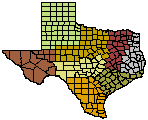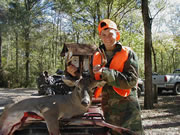- Trans Pecos
- High Plains/Panhandle
- Cross Timbers
- Hill Country
- Post Oak Savannah
- Pineywoods
- Oak Prairie
- South Texas Plains

Wildlife Division District Map
Deer Harvest Management and Predator Control
To sustain ecosystem health, deer and livestock populations must be maintained at or below carrying capacity of the habitat. Carrying capacity is defined as the maximum number of individuals a population can support within local habiat conditions(food, water and cover). To accomplish this, programs are available for landowners and leaseholders to obtain permits to legally harvest antlerless deer in counties that prohibit the harvest of antlerless deer during the regular deer season. Such programs include,
Managed Land Deer Permits (MLDP),
Landowner Assisted Management Plans (LAMPS),
Predator Control
Native and introduced predators abound in the Post Oak Eco-region. Indigenous predators such as coyote and bobcat prey on many wildlife species including deer. Studies conducted in the Post Oak Eco-region indicate significant fawn losses due to coyote predation. Fecal sample analysis of coyotes found deer hair in droppings during every month of the year. Native predators, such as bobcats, coyotes, raccoons, skunks, foxes, and snakes, have an impact on birds, small mammals and herptofauna. While natural predators are an integral part of an ecosystem, it is sometimes desirable to control their numbers just as it is a deer population. Implementation of a predator control program may be an effective tool in protecting some wildlife species. The optimum time for coyote control to reduce impact on fawns is from January through March, before coyote pups and deer fawns are born.
Non-native species that can be detrimental to wildlife populations are fire ants and feral hogs.
Areas with high densities of fire ants can impact the survival
of many wildlife species. Fire ants attack deer fawns, young birds, small
mammals, and reptiles. Furthermore, fire ants compete with species such
as Texas horned lizards and young quail for food. This limiting factor may
be the most significant reason for the decline of these species.
It is generally not practical or necessary to attempt to control fire ants
on large land tracts, but it is often useful to attempt to establish some
fire-ant free areas. The product Logic is one choice for fire ant control.
Some studies have indicated that it works best when used in September because
of the time lag. September use is reported to control fire ants through
the bird nesting season the following spring. The County Agent may provide
additional information on fire ant control.
FERAL HOGS should be controlled by shooting, live trapping, and using dogs whenever possible. Most success at this usually occurs during the winter when feral hogs are having to travel more to find food. Besides rooting up pastures, feral hogs compete directly with deer, turkey and most other wildlife species that rely heavily on acorns and other hard and soft mast for winter food. Deer also tend to avoid areas when feral hogs are present.
For specific information about Leopold's 5 tools as the Apply to the Post Oak Savannah and Blackland Prairie, please click on the appropriate category below.
Brush Control and Forest Management
Harvest Management
